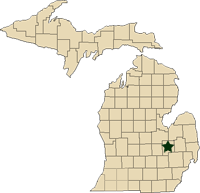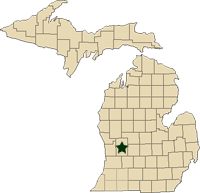Regional reports on Michigan fruit – March 19, 2012
MSU Extension educators’ pest and fruit updates for Michigan.
This week’s regional reports:
- Southeast Michigan - Bob Tritten
- Grand Rapids Area Tree Fruit - Amy Irish Brown and Phil Schwallier
Southeast Michigan – Bob Tritten, Michigan State University Extension
|
Weather
Our degree day accumulations continue to increase extremely rapidly and we are so far ahead of normal that it’s hard to put a number of days with it. We are at least a month ahead for degree days and more than three weeks ahead for tree growth stages, compared to 35-year averages.
It has been amazing to see the change in fruit flower bud development from early morning to late evening. This is a spring season that I have not experienced in my 33 years with MSU. In fact, the same is true for most of us involved in fruit farming. The well-heeled fruit growers among us keep referring to 1945 as the earliest spring bud break that they can remember. We are ahead of that year already.
We can use DD Base 42 to track tree growth. With the very warm days and nights, degree days have been accumulating faster than tree growth can keep up. The degree days are ahead of the tree growth stages this year and most likely will continue that way for the rest of the year.
Here are some dates that Amy Irish-Brown shared with her growers that will help you reference normal first green for McIntosh (or other mid-season varieties) in the Grand Rapids, Mich., area:
- 2012 – March 17
- 2011 – April 12
- 2010 – March 23 (another early year)
- 2009 – April 12
The “normal” green tip for her is April 11.
|
Southeast Michigan growing degree day totals for March 1 to March 18 | |||
|
Location |
GDD42 |
GDD45 |
GDD50 |
|
Commerce (Oakland) |
154 |
123 |
79 |
|
Emmett (St Clair) |
144 |
115 |
73 |
|
Flint (Genesee) |
164 |
131 |
87 |
|
Lapeer (Lapeer) |
162 |
131 |
87 |
|
Petersburg (Monroe) |
168 |
136 |
89 |
|
Pigeon (Huron) |
138 |
110 |
70 |
|
Romeo (Macomb) |
150 |
119 |
74 |
Tree fruits
Apples are mostly at 0.15-inch green. Apple grain aphids are just beginning to be seen. With rain predicted for late this week, we may have our first apple scab infection wetting period for the season. Growers need to be ready to go on this important disease. Spore monitoring equipment is working at both of our stations. Spore development could be delayed somewhat this spring due to little snow cover over the winter. However, the warm winter might offset that. Be ready for scab and don’t miss the first cover spray – they are important, even with very little foliage present.
New research at Cornell University found that the use of copper for that first scab spray versus not using it resulted in a significant decrease in the amount of scab lesions at the end of the growing season compared to when it was not added. The seasonal fungicide program was the same for both treatments and the only difference was the early copper application. Copper is not as inexpensive as it once was, but it is still a good early season scab spray. This year, with it being so warm, it is also very safe to use it. Dormant oil applications are also being made.
Pears are at bud burst. Pear psylla adults have been seen flying in high numbers for the last five days.
Peaches are at late swollen bud with just a bit of green tissue being seen. Copper sprays have gone on in most peach blocks.
Sweet cherries are at swollen bud and very close to bud burst. Copper applications should be timed for before or right at bud break. This could happen quickly, so watch your blocks closely.
Tart cherries are at swollen bud to bud burst.
Plums are beyond bud burst and very close to green cluster.
Small fruits
Strawberry leaves continue to emerge from the crown, with no flower buds emerging. I would encourage growers to hold off on removing straw mulch for as long as possible.
Raspberries are at leaf emergence for summer fruit types and new canes are just starting to emerge for the soil for fall bearing raspberries.
Blueberry buds are swollen with just a bit of green tissue emerging late yesterday afternoon (Sunday, March 18).
Grapes are at bud swell.
Back
to top
Grand Rapids Area Tree Fruit– Amy Irish Brown and Phil Schwallier, Michigan State University Extension
|
Weather update
Degree day accumulations continue to increase extremely quickly and we are so far ahead of normal that it’s hard to put a number of days with it. It’s at least a month ahead for degree days and a little more than three weeks ahead for tree growth stages, compared to 35-year averages.
For tree growth, we can use DD Base 42 to track tree growth. With the very warm days and nights, degree days have been accumulating faster than tree growth can keep up. The degree days are ahead of the tree growth stages this year and most likely will continue that way for the rest of the year.
As a reference, normal first green for McIntosh (or other mid-season varieties) in the Grand Rapids, Mich., area is around April 11. This year, first green on Macs was March 17.
Dates of first green on Macs for recent years:
- 2012 – March 17
- 2011 – April 12
- 2010 – March 23
- 2009 – April 12
Tasks that need to be done right away include:
- Continue to finish up pruning and get brush out of orchards.
- Get sprayers up and going.
- Copper applications on sweet cherries should be timed for before or right at bud break – this could happen quickly so watch your blocks closely.
- Copper applications on apples should be timed for before 0.25- inch green – this could happen very fast this year so don’t wait too long.
Apple scab
I expect that we will get our first scab infection sometime late this week as a rainier pattern seems to be moving our way. Spore monitoring equipment is out and working. Spore development could be delayed somewhat this spring due to little snow cover over the winter. However, the warm winter might offset that. I’ve done some squash mounts of some old lesions to better determine how ascospore maturity is moving this season and there are a few ascospores that are ready, but it appears to be a normal development. Be ready for scab and don’t miss the first cover sprays – they are important, even with very little foliage present.
There is some new research out of Cornell University that looks at the use of copper for that first scab spray versus not using it. In the blocks where copper was added, there was a significant decrease in the amount of scab lesions at the end of the growing season compared to when it was not added. The seasonal fungicide program was the same for both treatments and the only difference was the early copper application. Copper is not as inexpensive as it once was, but it is still a good, early season scab spray. This year, with it being so warm, it is also very safe to use it.
Insects
For those with pears,
psylla is out on expanding buds and sprays should go on if you haven’t already.
If you are using mating disruption or doing any kind of trap monitoring this
year, be sure to get your supplies ordered soon.
Disruption for codling moth
in apples and pears should be up before bloom in apple, but you can get started
on it anytime. Traps for red-banded leafroller can go up soon as well as
spotted tentiform leafminer. The warmer nights will get some of these
Lepidoptera pests moving. Apple grain aphids could make an appearance at any
time. If you have time, scout those blocks where you had European red mite
problems last year, looking for overwintering eggs. I would expect they
survived the winter just fine this year.
Back to top



 Print
Print Email
Email





